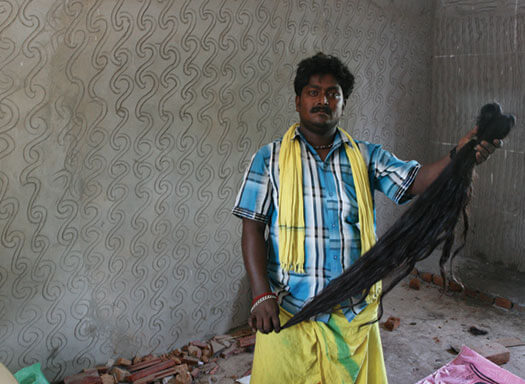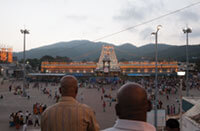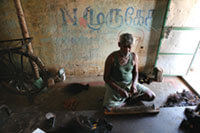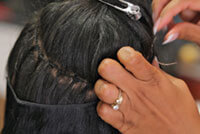Black Gold

In Chennai, India, a man gathers hair. India is the origin of much of the world’s superior-quality remy hair, which is in high demand for wigs and extensions. Remy is considered the highest quality human hair because it is harvested in a single cut, preserving the original orientation and giving hairpieces a natural look. Photos: Scott Carney
From a temple in India to American beauty salons, a global trade network spins hair into … Black Gold
Investigative journalist Scott Carney MA’04 spent five years researching The Red Market: On the Trail of the World’s Organ Brokers, Bone Thieves, Blood Farmers, and Child Traffickers. The book sheds light on the little-known and sometimes macabre trade in human body parts — from an Indian village where most of the impoverished residents have sold their kidneys, to body snatchers who steal bones from graves for use in medical schools and labs. This excerpt, one of the book’s chapters, deals with the demand for human hair — a global market that brings in $900 million annually. Carney, who lives in Long Beach, California, is a senior fellow at the Schuster Institute for Investigative Journalism. His work has appeared on NPR, BBC, and National Geographic TV, and in Mother Jones, Fast Company, Discover, and the New York Times Magazine.
An attendant peeping out of an old-fashioned bank-teller window stashes my shoes in a giant pile with a thousand other pairs. From here there is no way out. A ripe throng of humanity presses me through a series of wrought-iron gates, and I trip along crumbling bits of concrete. As we make the transition from the entranceway to the inner sanctum, cool white ceramic tiles replace the broken flooring. It takes fifteen minutes to inch my way forward through the herd of people pressed together like cattle to where a uniformed man in a booth hands me a paper token imprinted with a bar code and a picture of Venkateswara — an incarnation of the Hindu god Vishnu. The next official I meet a few feet away, clad in a stained brown shirt, hands over two razor blades: one for my head, the other for my face.
The crowd of men and women proceed down a wide staircase, whose landing is covered in a soggy mixture of tepid water and black hairballs. The air is moist and smells of rancid coconut oil. The stairs end at a vast, tiled chamber resembling a neglected Olympic swimming facility where long lines of men face tiled benches running along the walls. (Women are herded into a separate room.) In the center are four massive steel vats.
I match my token code — MH1293 — to a sign on the wall and then take my place in a queue of about fifty bare-chested men in black sarongs. The pilgrim at the head of the line bows low as a man with a straight razor makes swift work of his curls. Satisfied, the barber looks up, spots me, and beckons me forward. He has a ragged cloth tied around his waist over white striped boxer shorts. No high priest, clearly. Just a worker bee for the holy hive.
I assume the position as he fixes my blades to the razor handle. “Start praying,” he says. I try to remember the god’s face, but there’s no time to contemplate: the man forces my head downward and runs the blade down from the top of my head with the practiced efficiency of a sheepherder. Satisfied, he grabs my chin, sticking a thumb in my mouth as he prepares to dispense with my beard. I watch the brown hair fall away in clumps, joining the dark, wet mash underfoot.
The curly-haired guy who was ahead of me is also now bald, with small nicks in his scalp and pink streaks of blood dripping down his back. He meets my eyes and smiles broadly.

Indian women sort hair for market. Good-quality human hair can fetch more than $100 a pound at auction.
“Venkateswara will be pleased.” His wife is offering her hair in the other room. Together they will return to their village bearing a symbol of humility and devotion that all will recognize. A woman in a blue sari flashes by and scoops my hair from the gutter into a bucket. Each time her bucket fills, she stands on her tiptoes and empties it into one of the tall vats. By day’s end all four will be filled with hair destined for the auction block.
Welcome to the Kalyana Katta hair-tonsuring center at the Sri Tirumala Temple in Andhra Pradesh, India: the genesis point for the world’s most lucrative trade in human detritus. Hair collected here feeds into the half-billion-dollar beauty industry that weaves real “premium grade” Indian hair onto the heads of mostly African-American women who want long straight hair. The global market for human hair tops out at almost $900 million in sales, and that doesn’t include the installation costs that salons charge.
Women seeking a high-end look know what to ask for. It’s called “remy” hair, which is more or less synonymous with hair from India. Top salons prize it for the way it’s collected, in a single cut, which preserves the orientation of the hair’s shingle-like outer layer, and thus its strength, luster, and feel. That’s what defines remy, and that’s the reason it commands a premium price. The hair’s journey, shorn from the heads of the devout and sewn onto the skulls of America’s new glamouratti, is a supply chain unlike any other: altruism, transparency, and commercialism are perfectly balanced.
Name-dropped in the ancient Hindu epic the Mahabharata, Tirumala is holy ground for fifty thousand annual pilgrims who arrive daily from across South Asia to seek favors from their god. In addition to monetary donations, about one in four offers their hair, which will then be offered to the gods of the marketplace, reaping a reported $10 million to $15 million each year. Including donations, the temple boasts that it takes in more money than the Vatican — a dubious claim. In any case, temple leaders announced a plan to plate the walls of the inner sanctum with gold. Profits from the hair are used to support temple programs and feed the needy.
Indian hair is sold to two distinct markets. The bulk of it, some five hundred tons per year from short-haired men like me, is purchased by chemical companies that use it to make fertilizer or L-cystine, an amino acid that gives hair its strength, but also makes an excellent additive for baked goods and other products. The more lucrative hair of female pilgrims — temple employees call it “black gold” — is tied in individual bundles and brought to the tonsuring center’s top floor, where women in cheap flower-print saris labor over small heaps of the stuff, sorting it by length. An armed guard frisks all who exit. There’s no way anyone is going to get past him with a single precious strand.
The reincarnation of temple hair as a beauty accessory started out as a relatively humble affair. Until the early 1960s, the temple simply burned the hair it collected. Citing pollution, the government banned the practice during the 1990s, but by then the temple had already found a more profitable way to get rid of the waste. Wig makers began seeking raw materials at Tirumala. At the temple’s first auction, in 1962, the hair sold for 16 rupees a kilo — about $24.50 in today’s dollars. Now it fetches up to ten times as much, and the auctions have become cutthroat affairs.
To see for myself, I drive a few miles to the bustling town of Tirupati, where the temple’s marketing unit operates out of a string of warehouses filled with drying hair. In a large boardroom, Indian traders representing forty-four companies are crowded around tables, prepared to drop millions of dollars in a complicated process of backroom negotiations. “The hair business is unlike any other,” says Vijay, who owns a hair-exporting house called Shabanesa, and like many South Indians, goes by a single name. “In any other business, buying a commodity is easy; it’s the selling it to retailers that is difficult. Here it’s all reversed. It’s simple to sell hair, just difficult to buy it.”

The Sri Tirumala Temple in Andhra Pradesh is the starting point for the half-billion-dollar global hair industry. Pilgrims at the temple allow their heads to be shaved as a sign of humility. Hair sales fund the temple and programs to feed the needy.
When sold in bulk, hair is the only human tissue that can be treated like an ordinary commodity, bought and sold by the pound. It’s the only case of pure altruism actually working in a market for human materials. But that doesn’t mean hair sellers don’t squabble over the profits.
I can see the tensions at the auction. The temple is pressing for a better price than last year’s, and traders are worried that the global economic recession will batter the extensions market. Halfway through the evening, India’s largest hair reseller — K. K. Gupta, whose Gupta Enterprises did a brisk $49 million in sales in 2008 — accuses the temple directors of trying to set an inflated price and walks out. After an hour, which Gupta spends in the parking lot making calls and threatening to go to the papers, the price is set slightly lower. Then another reseller loudly charges that Gupta is trying to corner the market. A muscular bidder has to step in to prevent fisticuffs.
Another three hours and it’s approaching midnight. The price for the longest and most durable product hovers around $193 per kilo ($70 less than the previous year, I’m told). Over the next few days, trucks will deliver the hair to the distributors’ factories, where the alchemy of transforming human waste into a luxury product takes place.
Some eighty-five miles from the auction site, in an industrial lot on the outskirts of the coastal metropolis of Chennai, George Cherian, chairman of Raj Impex, one of India’s largest hair-export houses, awaits his delivery. The hair must be checked for lice, painstakingly untangled, washed in vats of detergent, and combed until it’s of export quality. “The real value of what we do is right here, when we grade the hair and transform it from waste into something beautiful,” Cherian says. He pulls out a handful of smoothed hair the size of a riding crop, noting that it will fetch $15 on the international market.
The bulk of hair sold in India isn’t tonsured, he notes — it comes from garbage bins, the floors of barbershops, and the combs of long-haired women. Nomadic families and small businesses go door to door bartering hair clips, rubber bands, and trinkets for it. “This work supports tens of thousands of people across India in cottage sorting and collection industries,” Cherian says. “The rule is simple: remy hair goes to the U.S., the rest goes to Africa.”
In a storage room, he shows me 400 kilos of remy hair packed in boxes and bound for cities throughout the world. His warehouse contains several tons more, ready to ship. “The demand is huge,” Cherian says, “but I don’t think that anyone outside of India would ever be able to do this. We survive because of the cheap labor. No one in Italy, or California, could prepare the hair for less.”
When I asked him about the nonremy industry, Cherian suggests that I contact a band of gypsies who live by the railroad tracks north of Chennai. He tells me, though, that I’ll have to leave early if I want to catch them.

A man in Chennai combs hair. There are two distinct markets for this human product: long, luxurious hair ends up in wigs; short hair (500 tons a year) becomes fertilizer and baking additives.
At eight in the morning, I’m behind the wheel of a black Hyundai Santro, dashing north through the city’s narrow streets. Beside me is one of Cherian’s agents, named Damodharan, who relays with gypsies and buys their product in bulk. He points me down a dirt road offshoot near a former colony for railroad workers and we turn into what looks like a barren field. But as I look closer, I can make out a group of people squatting in the shadows over a small open fire. Damodharan jumps out and pulls me over to meet Raj, a slender twenty-something man with a thick crop of black hair on his head. When I tell him I’m interested in knowing about hair selling, he smiles broadly and walks back to his encampment and fishes around inside a large pipe that looks like it is there to drain runoff. Then, with a flourish, he pulls out a giant plastic bag and brings it to me.
I look over curiously and he reveals a pillow-sized greasy black hairball. “You can find hair almost anywhere,” he says. In the mornings, he shoulders a large canvas sack on his back and trolls the side streets looking in trash cans and along roadsides. “People just throw it out, or sometimes if they save it up for us, we will trade them,” he says. Damodharan gives Raj 800 rupees ($20) for the full sack of cast-off nonremy hair that he has collected.
Back at the Raj Impex factory, workers will comb out literally thousands of similar dreaded hair balls. Once the hair is separated, workers will bundle it into batches and sew it onto cloth strips. Processing nonremy hair is extremely labor intensive, but only about a third as lucrative. If it’s long enough, it goes into budget-priced wigs. Otherwise, it is transformed into mattress stuffing or boiled down into food additives. Still, with hundreds of thousands of tons of it available, the hair resellers can find a way to profit from it. Like any other commodities market, a plentiful supply of cheap hair means that someone will find a way to make use of it and spur demand somewhere.

From India to the United States: at an American salon, remy hair is turned into a weave for a client. Photo: Tony Kurdzuk/Star Ledger/Corbis
From Chennai, the best-quality hair travels to almost every beauty parlor and hair salon on the planet, but, as mentioned earlier, finds its most profitable reception in predominantly African-American neighborhoods where customers value Indian hair for its dark, luxurious hues and straightness. One of those places, the Grooming Room on Brooklyn’s Nostrand Avenue, a street so densely packed with beauty outlets that it almost seems zoned for that purpose, is managed by Tiffany Brown, a high priestess of hairstyles. When I first meet her on a Friday, her face is framed by closely cropped bangs and long tresses that hang to her chin. On Saturday she looks altogether different, with hair pulled tight against her scalp into a ponytail just an inch long. By Sunday she might well wear glamorous locks cascading down her back. The secret of Brown’s chameleon powers: remy hair from factories like Raj Impex.
It’s “a necessary accessory, like earrings or a necklace,” she says. “It lets me be whoever I want to be for a day.” Her clients feel the same way; they spend about $400 a month maintaining their extensions, she says, though a few drop thousands. Between shops like hers and celebs who might shell out $10,000 or more for a single wig or weave, there is a near-constant demand for Indian locks. “If you want cheap hair,” sniffs a supplier’s blog called thelookhairandmakeup.com, “you’re going to get a cheap-looking hairstyle.”
“The only hair worth buying is remy,” says one of Brown’s clients, her hair wrapped around enormous curlers. “They say that it’s cut from the heads of virgins.” Though not strictly true, the hair woven onto her head went from being an act of humility and altruism in the name of God, to one of America’s most recognizable glamour enhancers. n
From the book The Red Market: On the Trail of the World’s Organ Brokers, Bone Thieves, Blood Farmers, and Child Traffickers by Scott Carney. Copyright © 2011 by Scott Carney. Reprinted by permission of William Morrow, an imprint of HarperCollins Publishers.
Published in the Winter 2012 issue




Comments
No comments posted yet.